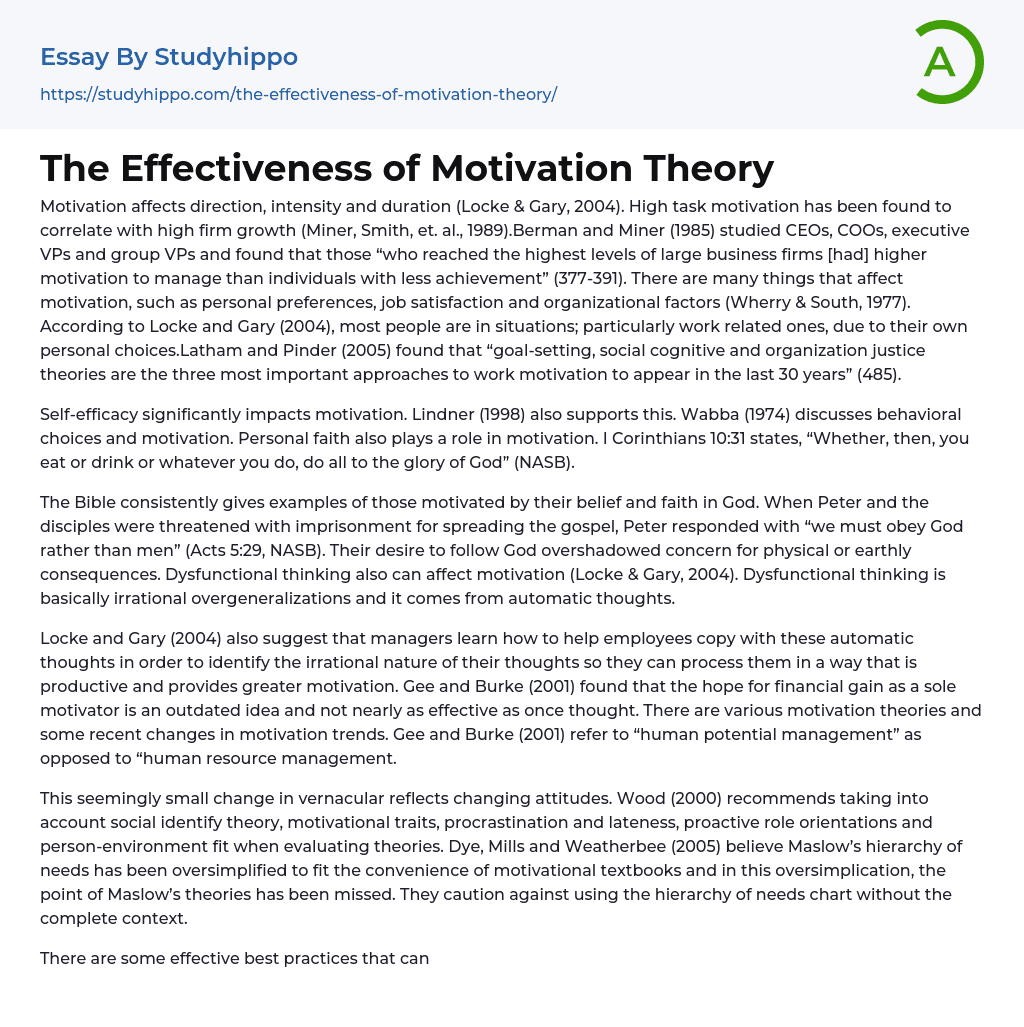Motivation affects direction, intensity, and duration (Locke & Gary, 2004). Increased firm growth has been observed to be positively associated with high task motivation (Miner, Smith, et. al., 1989). Berman and Miner (1985) conducted a study on CEOs, COOs, executive VPs, and group VPs and discovered that individuals who reached high positions in large business firms demonstrated a greater motivation to manage than those with lower levels of achievement (377-391). Motivation can be influenced by various factors including personal preferences, job satisfaction, and organizational factors (Wherry & South, 1977).
According to Locke and Gary (2004), individuals find themselves in various situations, especially those related to work, as a result of their own decisions. Latham and Pinder (2005) have identified goal-setting, social cognitive, and organizational justice theories as the primary approaches to work motivation that have emerged in
...the past 30 years (485). The impact of self-efficacy on motivation is significant and supported by Lindner (1998). Wabba (1974) explores the relationship between behavioral choices and motivation.
Personal faith, as stated in I Corinthians 10:31, plays a role in motivation. The Bible consistently provides examples of individuals who were motivated by their belief and faith in God. For instance, when Peter and the disciples faced the threat of imprisonment for spreading the gospel, Peter declared that they must obey God above all else. Their desire to follow God took precedence over any concerns about physical or earthly consequences. Additionally, motivation can be impacted by dysfunctional thinking (Locke & Gary, 2004).
Dysfunctional thinking refers to irrational overgeneralizations that stem from automatic thoughts. According to Locke and Gary (2004), managers should learn how to assist employees in dealing with these automatic thoughts,
enabling them to recognize the irrational nature of their thoughts and process them in a productive manner, leading to increased motivation. Additionally, research by Gee and Burke (2001) indicates that the notion of financial gain as the sole motivator is outdated and not as effective as previously believed. Multiple motivation theories exist, and there have been recent shifts in motivation trends. In fact, Gee and Burke (2001) propose the concept of "human potential management" in contrast to traditional "human resource management," reflecting changing attitudes.
Wood (2000) suggests considering social identity theory, motivational traits, procrastination, lateness, proactive role orientations, and person-environment fit in evaluating theories. According to Dye, Mills, and Weatherbee (2005), Maslow's hierarchy of needs has been oversimplified for the sake of convenience in motivational textbooks, resulting in a misunderstanding of the essence of Maslow's theories. They advise against using the hierarchy of needs chart without considering the complete context. From motivation theories, one can derive certain effective best practices.
According to studies conducted by Gee and Burke (2001), self-managed teams and telecommuting have a positive impact on employee motivation. Similarly, Tai (2006) and Huang (2001) have found that effective training programs are correlated with higher levels of employee motivation. In addition, Chapman (2008) suggests that team-building activities, workshops, inspirational quotes, and positive experiences play a role in building employee motivation. Sodenkamp (2005) discovered that pay-for-performance systems implemented on employee work groups can also increase motivation. The ACCEL-Team's (2008) research supports these findings. However, Fitzgerald (1971) warns against using irrelevant solutions to motivate employees before ensuring a solid foundation in the work system itself.
The motivation of individuals is influenced by the attitudes and actions
of managers. According to Daniel Goleman, there are six different leadership styles: coercive leaders who expect immediate compliance, authoritative leaders who inspire people towards a vision, and affiliative leaders who build emotional connections.
According to Longenecker, Moore, Petty ; Palich (2008), different leadership styles exist. For instance, democratic leaders work towards building consensus, pacesetting leaders establish high standards and demand excellence, while coaching leaders focus on developing individuals. Forsyth (2006) defines leadership as the process of guiding others in their pursuits through activities such as organizing, directing, coordinating, supporting, and motivating their efforts.
376). Invang (2008) provided guidance to his group members, stating that a manager who listens can encourage employee growth and career development (Burley-Allen, 1995, p. 9). Anthony (1989) emphasized the importance of motivation through leading by example and engaging with employees. Wolleat (2007) reviewed Gary Latham's book, which covers the history, theory, research, and practice of work motivation, and recognized its usefulness in presenting various motivation theories. However, Locke and Gary (2004) argued that motivation theories should not be seen as competing with each other, but rather as revealing different aspects of motivation. Therefore, the goal for managers should not be to compare and select a superior theory, but rather to draw on the characteristics of different motivation theories in order to effectively motivate employees.
- Bias essays
- Big Five Personality Traits essays
- Body Image essays
- Mind essays
- Motivation essays
- Phobias essays
- Thought essays
- Code of Ethics essays
- Conflict essays
- Dress Code essays
- Human Resources essays
- Organizational Behavior essays
- Performance essays
- Recruitment essays
- Safety essays
- Attitude essays
- Goals essays
- Personal Goals essays
- Personal Life essays
- Personality essays
- Principles essays
- Reputation essays
- Self Awareness essays
- Self Esteem essays
- Self Reflection essays
- Self Reliance essays
- Strengths essays
- Value essays
- Values essays
- Weakness essays
- Who Am I essays




